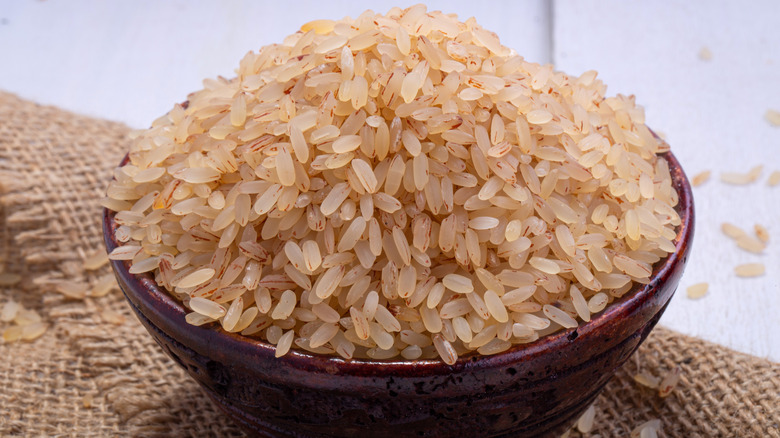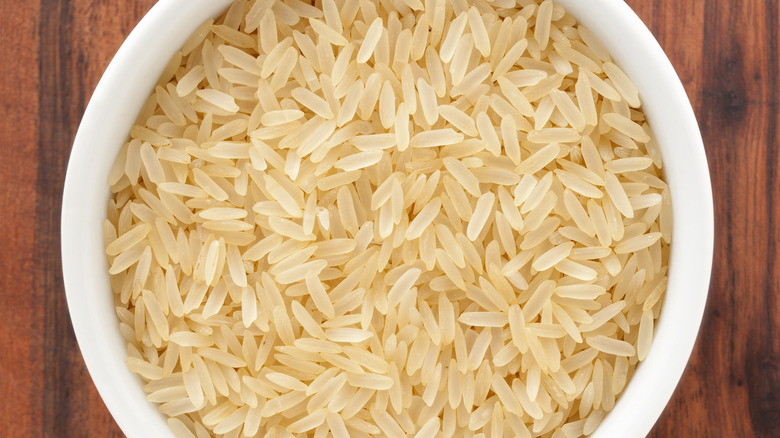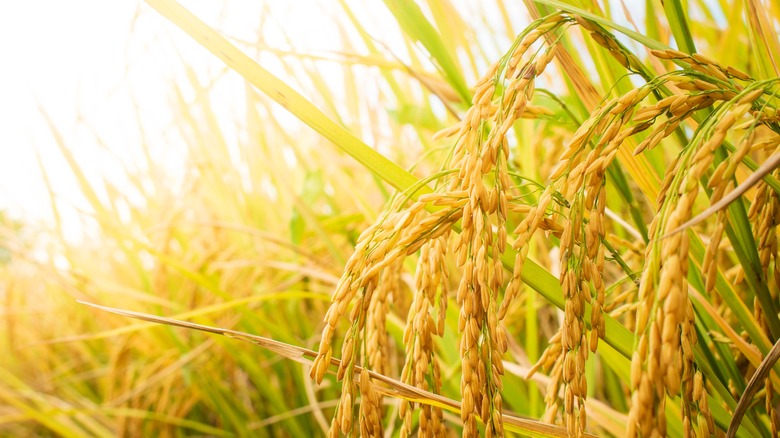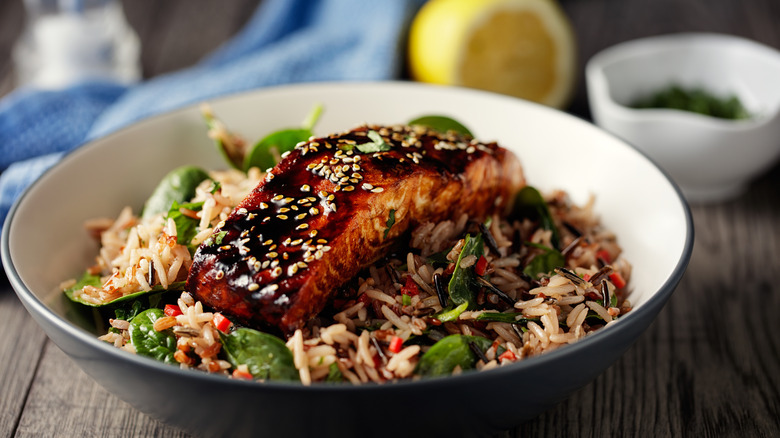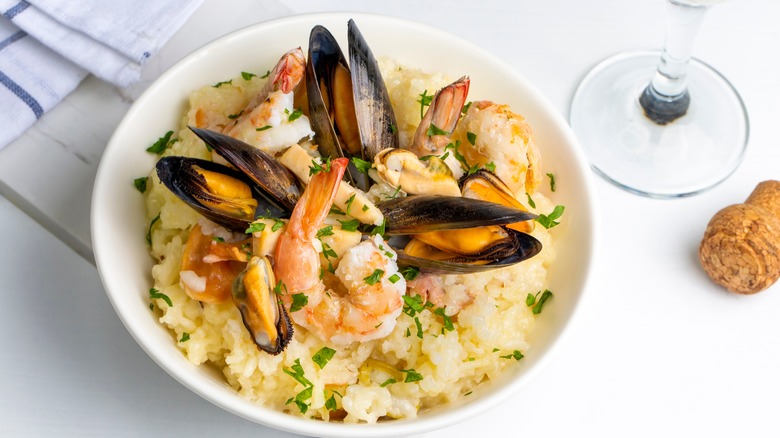What Exactly Is Converted Rice And How Should You Cook It?
Rice is one of the most basic foodstuffs on the planet, common to a huge number of cuisines and cultures that span the globe; it's a lot harder to find a cuisine that doesn't make any use of rice than one that does. There are also a huge number of varieties of the stuff: jasmine rice, basmati rice, sticky rice, wild rice, short-grain white rice, even forbidden rice. But there's one type you might not be aware of — only, it's not really a type at all.
Converted rice may seem like some weird new superfood, but it's not really strange at all; it's just rice that's been put through a different preparation process. It can be a great way to slow-cook rice because of its longer cooking time – and just as importantly, the process by which it is made can result in increased nutrients in your final product.
What is converted rice?
Simply put, converted rice is parboiled rice, which is a specific type of preparation that in rice's case results in increased nutrient content. Parboiling refers to essentially partially boiling the rice ahead of time. Parcooking, or partially cooking something before cooking it fully, is a common culinary practice, and it's the reason why twice-cooked french fries are so delicious. It's also how you avoid explosions when you're grilling sausages.
The main thing to understand here is that converted rice isn't a specific variety; almost any variety of rice can be put through the process that results in converted rice, although the most common types of converted rice you will see in stores are long and short grain. It's worth noting, though, that converted white rice (the kind you'll probably be using) will look slightly like brown rice. In order to understand why, it helps to fully appreciate how converted rice is actually made, long before it hits your table.
How is converted rice made?
The process is everything when it comes to converted rice. Typically, when rice is made, it gets harvested and dried, then its husks (the outer, inedible part of the rice grain) are removed. From there, different parts of the rice, like the bran and germ, might get removed in order to transform it from brown to white rice. For converted rice, however, it's the timing of when the husks are removed that changes things.
The harvesting and drying part remains the same, but, at that point, the rice grains get pressure-cooked with the husks still on. This darkens the color of the rice, but more importantly, it forces additional nutrients from the husk, bran, and germ into the starchy part of the rice, resulting in increased overall nutrient content than typical white rice (the nutritional profile thus actually winds up a lot closer to brown rice). The husks then get removed afterward because they're still not edible — but that initial cooking period has already done its work.
What does converted rice taste like?
For the most part, converted rice tastes like typical rice — you know it, you love it, you've eaten it hundreds of times. There are slight differences in taste between converted rice and more conventional rice, though. Typically, converted rice will have a slightly deeper flavor than its non-converted sibling; for instance, converted white rice will be slightly nuttier and earthier — somewhat more akin to brown rice, though not quite — than non-converted white rice thanks to the bran and germ being cooked into the grain during the parboiling process. Indeed, when you consider both the nutritional, color, and flavor changes, converted white rice is sort of a half-step between non-converted white rice and brown rice.
The other main difference between converted rice and non-converted rice relates to texture. Converted rice is far less likely to stick together than non-converted rice, meaning sticky and sushi rice (where sticking together is an important part of the application) are probably the only forms of rice where you really don't want to use converted rice.
How to cook with converted rice
The basics of cooking converted rice are the same as cooking any non-converted version of the same type of rice: you put it in boiling water seasoned to taste, then cover it until all the water has cooked away. The core process here functions the same way. There's really only one key difference: converted rice takes slightly longer to cook than the non-converted version of the same type of rice. That may seem counterintuitive because its parboiled nature means converted rice is partially cooked, but remember that converted rice is closer in texture and nutrition to brown rice and this makes a bit more sense. For example, where non-converted white rice takes 15-20 minutes to cook, converted white rice with the bran and germ cooked into the grain takes 20-25 minutes (which is still less than the 40 minutes it takes to cook brown rice). This may seem like a hassle, but it's actually something you can make work for your benefit.
Cooking rice slowly in something like soup is always a tricky proposition; how do you keep it from overcooking and getting soggy and mushy? Converted rice is a great answer because it naturally takes longer to cook anyway. You can use converted rice in slow cooker recipes much easier than you can with non-converted. It is still possible to overcook converted rice, but you've got a lot more leeway given the increased cooking time.
Where to buy converted rice
Happily, converted rice is pretty easy to find, as most major supermarkets carry it — no specialty stores are necessary here. Just make sure you're grabbing a package labeled "parboiled rice" because that's usually how it will be marked in stores. If, for whatever reason, you can't find it in your local grocery store, you can easily order it online from retailers like Amazon since dried grains like rice travel extremely well through the mail. You don't need to find some expensive specialty brand, either; parboiled rice is sold under household names like Uncle Ben's and Zatarain's.
All in all, converted rice is a great product if you're looking to slow-cook your rice or increase the nutrients in your dinner, and because it's so easy to find, you don't have to go out of your way to incorporate it into your repertoire. Try it sometime if you're looking to broaden your culinary toolkit.
